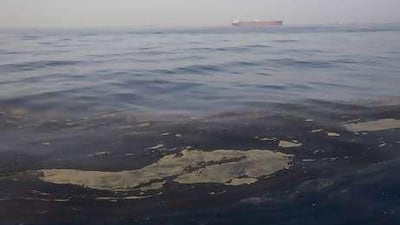The shipping lanes through the Arabian Gulf are some of the busiest in the world.
More than a third of the world’s seaborne oil shipments pass through the Straight of Hormuz.
In 2016, 50,700 ships passed the strait and 40,649 were tankers, according to regional monitoring watchdog, the Marine Emergency Mutual Aid Centre (Memac).
According to Marine Traffic, in the seven days after the oil spill on January 26, 248 distinct tankers passed through the Gulf.
About 140 tankers are currently in the anchorage area off Fujairah port with another 40 off Khor Fakkan, which is 20 kilometres north. Some of these have been there for years and the anchorage area can extend into international waters. For example, the crude oil tanker “City of Elite” arrived in 2016 and is flagged to Liberia. Some are used for storage, while others wait during periods of fluctuations in the market.
Because of the volume of activity, it makes the likelihood of a spill even greater. This happens through ship-to-ship transfers gone wrong, illegal cleaning of hulls or other reasons.
“The reason why [ship-to-ship transfers] occur in Fujairah and Khor Fakkan is because it’s the doorstep to and from the Gulf waters,” said Samir Madani, co-founder of Tanker Trackers, a website that tracks the movement of oil at sea.
“So if you have a tanker coming in from Asia that will want a couple of various grades [of oil] from countries like Iran, Saudi, Iraq, et cetera they can have smaller tankers deliver it to them there and they can keep the oil separated in the smaller storage tanks aboard the tankers.”
But UAE is at the centre of efforts to clamp down on pollution, punish those who flout the law and enforce strict regulations. There is also monitoring by the Coast Guard and Navy.
More broadly, Memac and the Regional Organisation for the Protection of the Marine Environment (Ropme) co-ordinate efforts in the region. Ropme and Memac are one organisation, with Memac being its working arm. Ropme is headquartered in Kuwait and Memac in Bahrain.
_______________
Read more:
Ministry looking into tackling east coast oil spills, FNC member says
Fourth oil spill in three months hits Fujairah
National Editorial: Deliberate oil spills need to be stopped
_______________
Ropme seeks to protect the marine and coastal ecosystems in the UAE, Bahrain, Iran, Iraq, Kuwait, Oman, Qatar and Saudi Arabia. It tracks oil spills, harmful algal blooms and other hazards that could threaten the sea area using satellites, including from Nasa, which are monitored daily and through an automatic shipping identification system.
Wahid Moufaddal is a remote sensing expert at Ropme and is responsible for operational environmental monitoring of the Arabian Gulf and Sea of Oman.
“In case of detection of any oil spill or significant marine or coastal pollution in the region, we report the case … and send an alert to Ropme's Marine Emergency Mutual Aid Centre (Memac) which is based in Bahrain to contact the concerned response team in the polluted marine or coastal area to act,” he said.
“Major oil spills are not very common in the region,” said Mr Moufaddal, but it’s also rare not to find some pollution by oil “here or there” in the seas surrounding the UAE.
There is now a concerted effort being made to clamp down on oil pollution in the Arabian Gulf. An important moment was in 2007, when the UAE signed up to the International Maritime Organisation’s “international convention for the prevention of pollution from ships”. Also known as the Marpol convention, it sets limits for discharges from oil tankers including in the “special area” of the Arabian Gulf into the Sea of Oman.
“In special areas, you can’t wash out any oily mixture, it has to go through a filtering system. And it cannot be more than 15 parts per million, meaning you would not expect to see any visible trace,” an IMO spokesperson said.
The convention also states that “any discharge into the sea of oil or oily mixture from the cargo area of an oil tanker shall be prohibited while in a special area”.
If traces of oil are discovered, then parties should investigate the issue.
“The investigation should include, in particular, the wind and sea conditions, the track and speed of the ship, other possible sources of the visible traces in the vicinity, and any relevant oil discharge records,” the convention states.
Since then, Memac said there has been a significant reduction in illegal discharges. There are also strict rules on the release of ballast water. Some ships have also been fined for illegally dumping into water. For example, oil tanker “Georgios” with a Liberian flag was caught by Memac last year discharging oily and chemical waste into the Omani sea. At the time, Memac director Captain A M Al Janahi, thanked the Omani and UAE authorities for efforts to combat sea pollution.
“The amount of oil pollution nowadays is much less than 10 years back,” Capt Janahi said.
But the high activity in the shipping lanes makes it difficult to monitor every single ship. Memac is studying the introduction of drones to increase the surveillance and for Mr Moufaddal, it will take a concerted effort to completely eradicate the problem including the correct application of guidelines, maritime conservative rules and other regulations.
“Enforcement of the law, increased surveillance and efficient marine environmental monitoring can also significantly limit the annual number of such incidents / offences,” he said.


